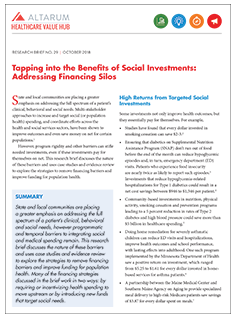Improving Value
Addressing Financing Silos
State and local communities are placing a greater emphasis on addressing the full spectrum of people’s clinical, behavioral and social needs. Multi-stakeholder approaches to increase social (or population health) spending and coordinate efforts across the health and social services sectors have been shown to improve health outcomes and even save money for certain populations.1
Yet program rigidity and other barriers can stifle needed investments, even if these investments pay for themselves on net. Barriers to financing social determinants of health investments include: programmatic barriers, temporal barriers and stakeholder mismatches. This Hub research brief discusses the nature of these barriers and uses case studies and evidence review to explore strategies for removing financing barriers and increasing funding for population health.
Strategies to increase social financing work in two ways:
(1) Requiring or incenting health spending to move upstream, through:
- Community benefit requirements
- Alternative provider payment models (e.g. global, capitated or bundled payment models, Shared Savings, etc.)
- State Medicaid waivers
(2) Introduce new funds to target social needs:
- Blended and braided financing
- CMMI/SIPPRA grants
- Public health bundles
- Pay for success
- Wellness trusts
Estimating the returns by stakeholder and to society at-large is, of course, easier said than done. The spectrum of benefits moves from cost-avoidance and/or savings that result from lower use of tertiary care (like hospital readmissions or Emergency Department services) to improved health outcomes to the long-term economic impacts like increased worker productivity or lower incarceration rates. It can be difficult to agree not only on which benefits should be included in these calculations, but how to measure the value of the more intrinsic outcomes like improved quality of life, wellbeing and patient experience.
Notes
1. Artiga, Samantha, and Elizabeth Hinton, "Beyond Health Care: The Role of Social Determinants in Promoting Health and Health Equity," Kaiser Family Foundation (May 10, 2018).
- Center for Health Care Strategies: State Payment and Financing Models to Promote Health and Social Service integration (February 2015).
- Robert Wood Johnson Foundation and Georgia Health Policy Center: Financing Population Health, Wellness Trust: A State-Based Prevention Fund Example (October 2016).
- Commonwealth Fund: ROI Calculator for Partnerships to Address the Social Determinants of Health







